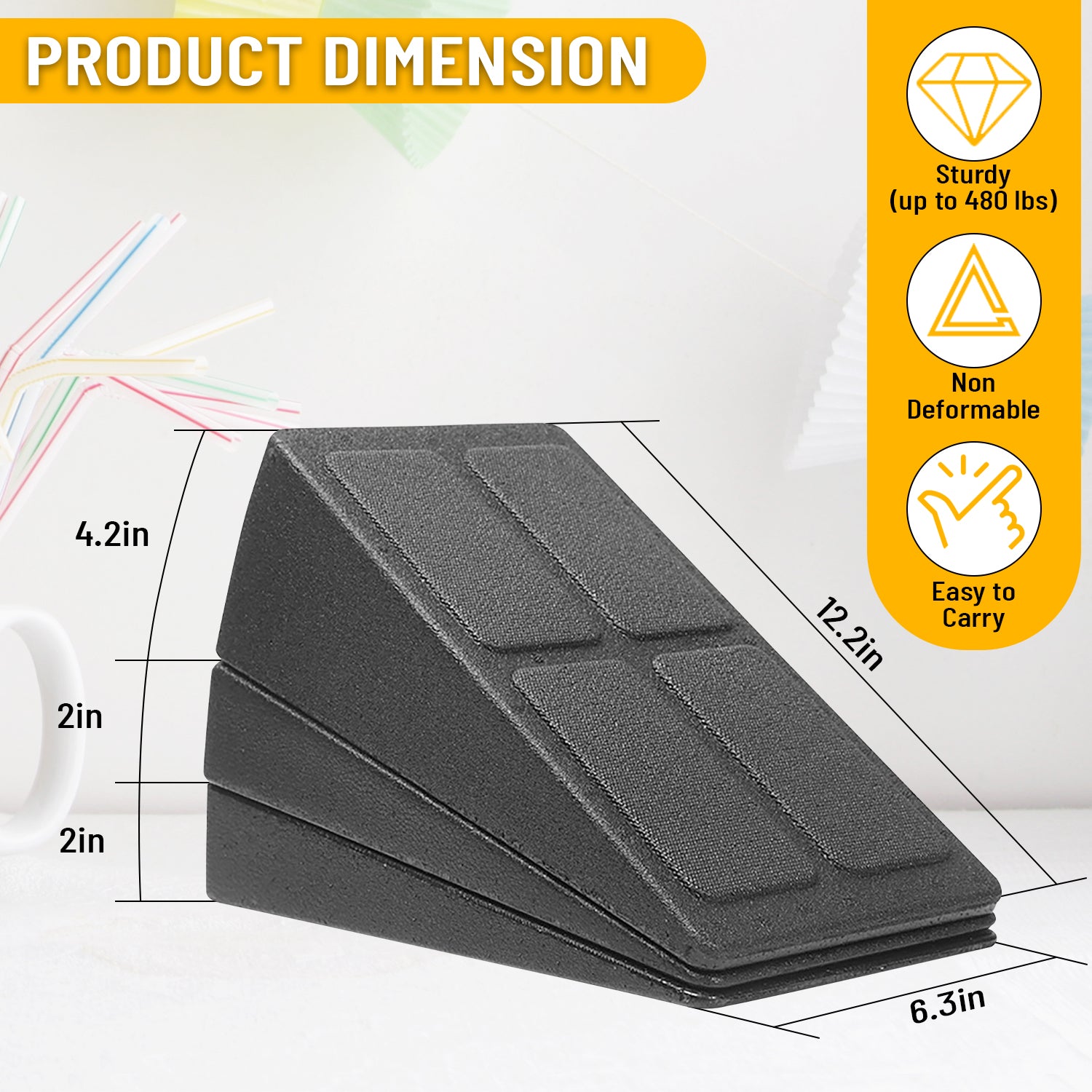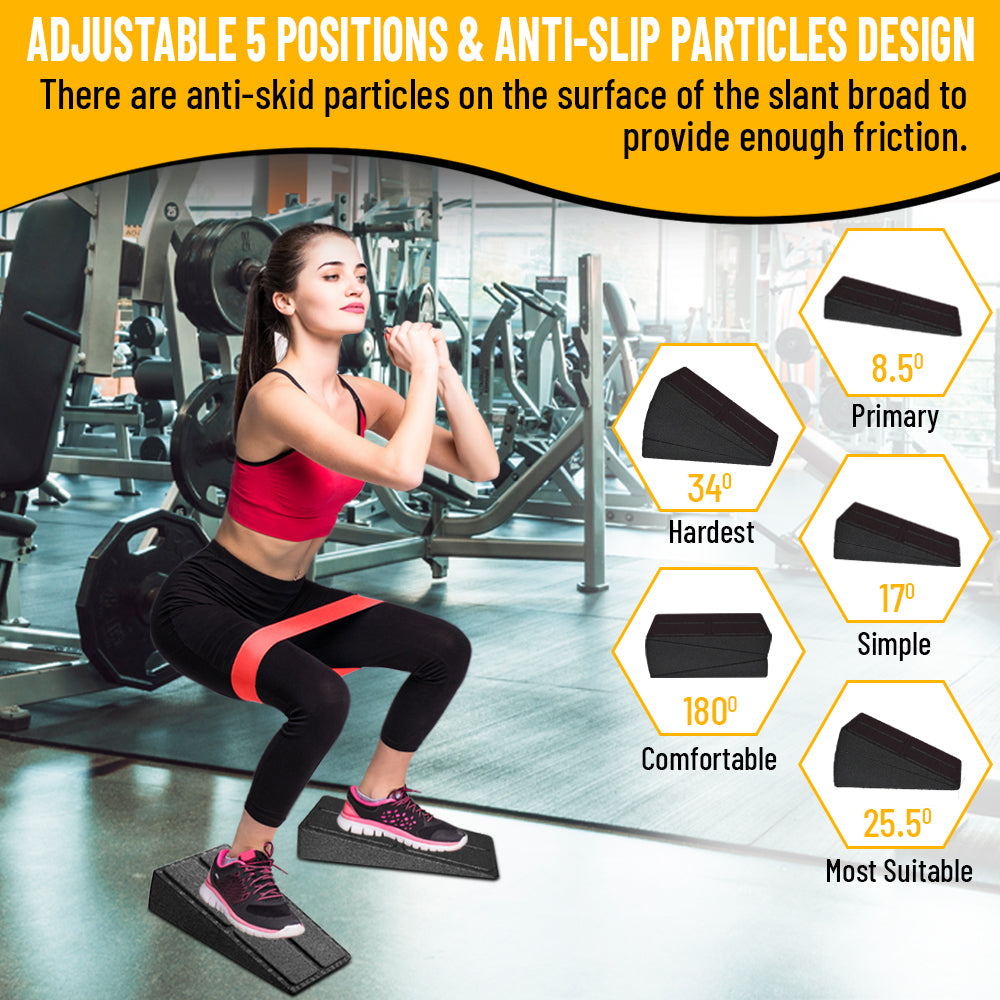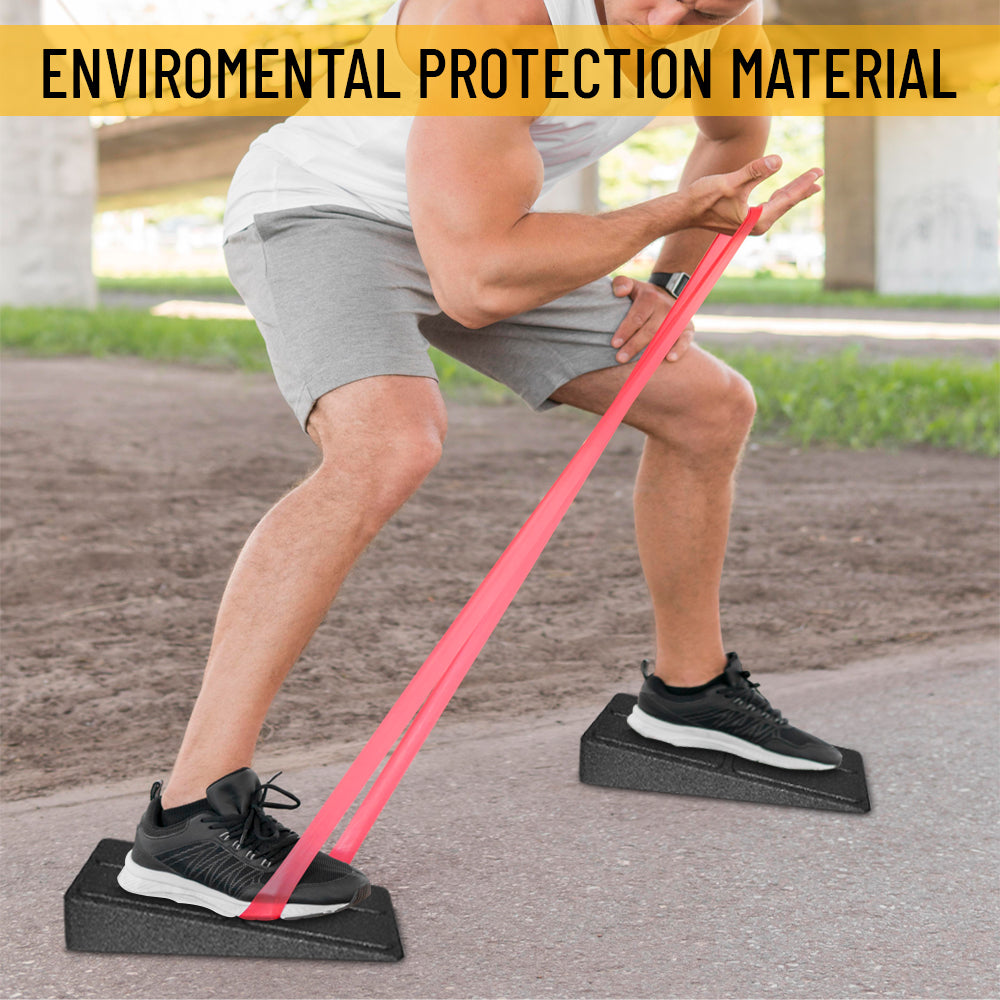
Top Exercises to do with Squat Wedges
Share
Are you looking to improve your squatting form and increase your lower body strength? Look no further than squat wedges! These wedge-shaped blocks are a game-changer when it comes to taking your workouts to the next level. By placing them under your heels during squats, squat wedges enhance your range of motion and provide better stability.
In this article, we will explore the top exercises you can do with squat wedges to achieve your fitness goals. Whether you're a seasoned athlete or just starting your fitness journey, incorporating squat wedges into your routine can help you improve your squatting form, increase lower body strength, and enhance stability.

By using squat wedges during exercises, you'll engage specific muscle groups while targeting your lower body. The added benefits of improved range of motion and stability will take your workouts to new heights.
Join us as we dive into the world of squat wedges and discover the best exercises to elevate your lower body strength training. Get ready to improve your squatting form, increase lower body strength, and experience a whole new level of stability with squat wedges!
So, whether you're a fitness enthusiast or a beginner looking to enhance your workouts, squat wedges are the secret weapon you've been waiting for. Let's get started on the journey to achieving your fitness goals!
Squat Wedge Exercises for Lower Body Strength
Are you looking to improve your lower body strength? Look no further than these five squat wedge exercises that target different muscle groups in your lower body. Incorporating these exercises into your workout routine can help you enhance your balance, stability, and overall strength. Let's dive in!
Squat Wedge Goblet Squat
The squat wedge goblet squat is an excellent exercise for targeting your quads, hamstrings, glutes, and core. To perform this exercise:
- Place a squat wedge under your heels.
- Hold a kettlebell, dumbbell, or medicine ball close to your chest.
- Stand with your feet shoulder-width apart.
- Lower your body into a squat position, keeping your chest up and hips back.
- Pause for a moment at the bottom, then push through your heels to return to the starting position.
Bulgarian Split Squat with Squat Wedge
The Bulgarian split squat is an effective exercise for targeting your quads, glutes, and hamstrings. Adding a squat wedge elevates your heel, allowing for greater activation of the leg muscles. Here's how to do it:
- Place a squat wedge under your back foot.
- Place your front foot a few feet in front of you.
- Lower your body by bending your front knee and lowering your back knee towards the ground.
- Keep your chest up and core engaged throughout the movement.
- Push through your front heel to return to the starting position.
Sumo Squat with Squat Wedge
The sumo squat targets your inner thighs, quads, glutes, and hamstrings. Using a squat wedge helps you maintain proper form and engage the proper muscles. Follow these steps to perform a sumo squat:
- Place a squat wedge under your heels.
- Stand with your feet wider than shoulder-width apart and toes turned slightly outward.
- Lower your body into a squat, keeping your knees in line with your toes.
- Pause at the bottom, then push through your heels to return to the starting position.
Deadlift with Squat Wedge
The deadlift is a compound exercise that targets your hamstrings, glutes, lower back, and core. Using a squat wedge can help improve your starting position and maintain proper form. Here's how to perform a deadlift with a squat wedge:
- Place a squat wedge under your heels.
- Stand with your feet hip-width apart.
- Hold a barbell or dumbbells in front of your thighs, with your palms facing your body.
- Hinge at your hips, keeping your back straight and knees slightly bent.
- Lower the weight towards the ground, maintaining a neutral spine.
- Drive through your heels and squeeze your glutes to stand back up.
Calf Raise with Squat Wedge
The calf raise targets your calves, helping you build strength and improve stability. The squat wedge provides an elevated surface for a greater range of motion. Follow these steps to perform a calf raise:
- Place a squat wedge under your heels.
- Stand with your feet hip-width apart and hands on a wall or a stable surface for support.
- Raise your heels off the ground as high as possible, feeling a stretch in your calves.
- Lower your heels back down, maintaining control throughout the movement.
Incorporating these squat wedge exercises into your lower body training routine can help you strengthen your muscles, improve your balance, and enhance overall lower body strength. Remember to start with lighter weights and gradually increase the intensity as you progress. Happy squatting!
Benefits of Using Squat Wedges
Incorporating squat wedges into your fitness routine offers a multitude of benefits that can help you optimize your workouts and achieve better results. Let's explore the advantages of using squat wedges:
1. Improve Ankle Mobility
Squat wedges promote ankle dorsiflexion, allowing for improved ankle mobility. This increased mobility enables you to achieve a deeper squat position, providing a greater stretch to your muscles and joints.
2. Increase Range of Motion
By elevating your heels with squat wedges, you can effectively increase your range of motion during squats. This extended range enables you to activate more muscles, engaging your entire lower body for a more comprehensive workout.
3. Reduce Knee Strain
Using squat wedges helps to shift your center of gravity slightly forward, reducing the strain on your knees. This can be particularly beneficial for individuals with knee issues or those who experience discomfort during traditional squats.
4. Target Specific Muscle Groups
Squat wedges allow you to target specific muscle groups during squats. By altering the incline angle, you can emphasize different areas of your lower body, such as your quads, hamstrings, glutes, or calves, to achieve a more targeted and effective workout.
5. Help Beginners
Squat wedges are especially helpful for beginners who may struggle with proper squat form. The raised heels provided by the wedges offer stability and support, making it easier for newcomers to maintain balance and learn the correct technique.
6. Improve Posture
Proper alignment and posture are crucial for executing squats correctly. Squat wedges encourage an upright posture by positioning your feet at a slight angle, ensuring proper spinal alignment and minimizing the risk of injury.
7. Provide Versatility
Squat wedges offer versatility in exercise options. Apart from squats, you can use them for various other lower body exercises like lunges or step-ups, amplifying the benefits across your entire workout routine.
Take a look at the table below for a summary of the benefits:
| Benefits of Using Squat Wedges |
|---|
| Improved ankle mobility |
| Increased range of motion |
| Reduced knee strain |
| Targeted muscle group activation |
| Helps beginners with squat form |
| Improved posture |
| Versatile for various exercises |
Conclusion
Squat wedges are a game-changer when it comes to improving your lower body workouts. These simple yet effective tools have the power to take your fitness routine to the next level, helping you achieve your goals faster and with better form and technique.
By incorporating squat wedges into your exercises, you can enhance ankle mobility, reduce knee strain, and target specific muscle groups more effectively. Whether you're a beginner looking to build strength or a seasoned fitness enthusiast aiming to push your limits, squat wedges are here to support you.
So why wait? Elevate your leg day and unlock the full potential of your lower body workouts with the power of squat wedges. Whether you're performing squats, lunges, or deadlifts, these wedges will improve your lower body strength, help you achieve your fitness goals, and maximize your gains.
Get your hands on the Bear Grips Squat Wedges today!
Shop at Amazon.com Now!
FAQ
What are squat wedges?
Squat wedges are wedge-shaped blocks that are placed under your heels during squats to improve your range of motion and provide better stability.
How do squat wedges improve squatting form?
By elevating your heels, squat wedges help improve ankle mobility and increase your range of motion during squats, allowing you to achieve a deeper squat position with better form.
Can squat wedges help increase lower body strength?
Yes, squat wedges can help increase lower body strength. By targeting specific muscle groups such as the quads, hamstrings, and glutes, squat wedges enhance the effectiveness of exercises like goblet squats, Bulgarian split squats, sumo squats, deadlifts, and calf raises.
Who can benefit from using squat wedges?
Squat wedges offer benefits for both beginners and experienced athletes. They can help beginners improve their squatting form and increase their lower body strength, while experienced athletes can use squat wedges to enhance their balance, stability, and overall performance.
What are the advantages of using squat wedges?
The advantages of using squat wedges include improved ankle mobility, increased range of motion during squats, reduced knee strain, targeted muscle group activation, improved posture, and versatility in exercise options.
How do squat wedges improve ankle mobility?
Squat wedges elevate your heels, which allows for a more upright torso position during squats. This helps improve ankle mobility by allowing your knees to travel forward while maintaining proper alignment.
Can squat wedges reduce knee strain?
Yes, squat wedges can help reduce knee strain. By improving ankle mobility and allowing for a more natural squatting position, squat wedges help distribute the load more evenly across your lower body, reducing the stress on your knees.
How can squat wedges improve posture?
Squat wedges promote better posture by encouraging an upright torso position during squats. This helps alleviate excessive forward lean, which can put strain on the lower back and lead to postural imbalances.
Are there different exercises you can do with squat wedges?
Yes, there are various exercises you can do with squat wedges. Some examples include goblet squats, Bulgarian split squats, sumo squats, deadlifts, and calf raises. These exercises target different muscle groups in the lower body and can be performed with the assistance of squat wedges for enhanced results.
How can squat wedges enhance my workout routine?
By improving ankle mobility, reducing knee strain, and targeting specific muscle groups, squat wedges can help you reach your fitness goals more efficiently and enhance your overall form and technique. They offer a versatile tool to take your lower body strength training to the next level.




